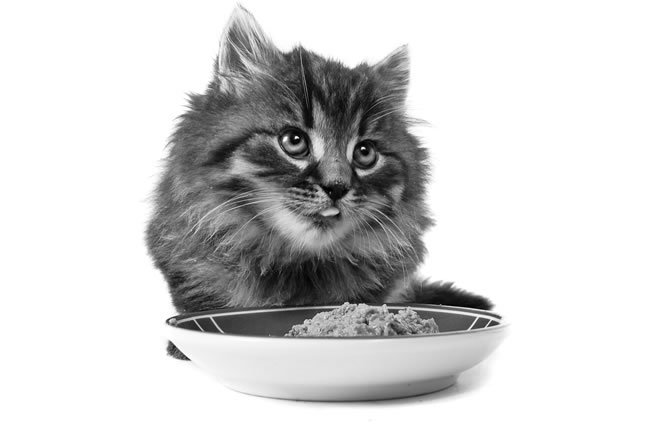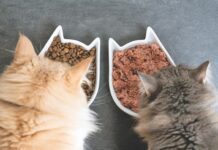In our quest to eat healthy food, we often extend that enthusiasm to our cats. We evaluate their diets with the same scrupulous care we give our own, but commercial cat food can still remain somewhat of a mystery. We question if preservatives are safe. Should we avoid genetically modified ingredients? What about artificial coloring?
Bigstock

Nutritionist Joseph Wakshlag, DVM, Ph.D., at Cornell University College of Veterinary Medicine, weighs in on ingredient safety with this advice: You can be the most effective advocate for your cats healthy diet. If you have questions after reading the label on his food, he recommends that you call the manufacturer directly and ask. It may be the best way to get a grasp on whats really in it. Most manufacturers will disclose secondary sources if you call them.
The big issue is about the sources that you dont know about, Dr. Wakshlag says. If manufacturers dont add it themselves, that doesnt mean it isnt in there because sometimes its in the ingredients they buy. If the manufacturer puts on the label that the dog food was preserved with rosemary, it doesnt mean that the product wasnt preserved with ethoxyquin [a preservative also licensed by the Environmental Protection Agency as a pesticide]. Consumers have to be a little bit inquisitive when looking at food labels because, from a packaging standpoint, there are a lot of ways to get around it.
Q. What do you think is the biggest consumer misconception about pet food ingredients?
A. That its inferior to what youre eating, whereas it is species-appropriate. It may be better than what most of us are eating because of the balance of healthy ingredients and because theyre routinely fed the same diet – with few trips to the fast-food drive-through.
Q. Consumers used to be worried about ethoxyquin. What is the current veterinary consensus about it? [While the Food and Drug Administration determined that ethoxyquin does not have any health consequences, its Center for Veterinary Medicine asked pet food manufacturers to limit its use voluntarily until there was more evidence that it was harmful to pets. The antioxidant is added to animal feed with the FDA stipulation that one of these statements be included on the product label: Ethoxyquin, a preservative or Ethoxyquin added to retard the oxidative destruction of carotene … and vitamins A and E. The label helps ensure the safe use of ethoxyquin, since there are established tolerances and a maximum use rate for this food additive, the agency says.]
A. I cant say that ethoxyquin is bad. Its the amount of it that we need to look at. We know that ethoxyquin, which preserves fats and other vitamins that get oxidized, has negative potential consequences when it is in high concentrations, above 150 parts per million. That is partially why the Association of American Feed Control Officials decreased the acceptable amount of it in pet food.
Q. Are natural preservatives healthier than chemical ones?
A. Everyone is looking for all-natural food. Many companies have gone to natural preservatives like rosemary and vitamin E. However, there are products that may have chemical preservatives in them like BHA or BHT in fish meal or poultry fat. The manufacturer will tell you that the product is preserved with natural tocopherols for preservation (which are antioxidants at the same time) that they add, but they do not need to label that the fat they bought had chemical preservatives that end up in the food.
The reason some of these products have to be preserved chemically is that the natural preservatives do not work as well as chemical ones in general. Their shelf life might be shorter. Synthetic ones were made for a reason: They were more effective, you didnt have to use as much, and in the end they are less expensive because they are all used in the human market ad nauseam.
Q. Should we avoid genetically modified corn and soy?
A. In general there is not much to worry about. We have been genetically modifying corn since the days of Mendel. One of the major issues is genetically modified (GMO) corn and soy that is weed-killer resistant. GMO corn and soy will make a protein that is resistant to certain weed killers. The grower keeps using them, and the corn and soy do not die and produce better yields.
Many initial studies said this is safe for consumption. But when researchers looked at what happens when 60 percent of a rats diet is weed-killer resistant GMO corn fed in pellets, some studies say its OK. Others say if you feed it to rats for their entire lives, they will get kidney lesions. But how many cats or humans are eating 60 percent GMO corn? Like everything else, its all about quantity – dose makes the poison – so there is a lot of controversy around it.
Q. How long will preservatives keep cat foods fresh?
B. They are safe to eat within nine to 12 months from the day of manufacturing. A high-fat food will go rancid quicker, because those usually contain about 20 percent or more fat, and those usually become rancid from being stored in a hot warehouse before being shipped to the retailer.
Q. Is artificial coloring safe?
A. We dont have any evidence that it is detrimental. We just dont know enough. Its not in many foods. If we had enough cats eating red coloring, there is a good chance we would find something negative, but its all in the quantity. Current toxicology studies suggest they are safe.
Q. Which by-products are OK and which are bad? How can you tell by reading the label?
A. It comes back to knowing your by-products. Good chicken meal is the whole chicken. Bad chicken meal is just the rib cages, necks and legs. To ascertain that, you have to call the manufacturers and ask how much ash [bone] is in their chicken meal, beef meal or bone meal. Some will have upward of 10, 12 or 16 percent. Thats a lot of bone and very little meat. The appropriate range of ash is 6 percent or so in good quality chicken meal.



